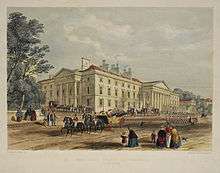John Foulston


John Foulston (1772 – 30 December 1841) was an English architect who was a pupil of Thomas Hardwick and set up a practice in London in 1796.[1] In 1810 he won a competition to design the Royal Hotel and Theatre group of buildings in Plymouth, Devon,[2] and after relocating he remained Plymouth's leading architect for twenty-five years.[1]
Urban Planning of Plymouth
At the time, Plymouth was a prosperous port town, separated along the coast of Plymouth Sound from the neighbouring towns of East Stonehouse and Devonport; collectively known as the Three Towns. Foulston was responsible for the creation of Union Street from the Frankfort Gate which was built across marshland to unite the three towns.[1]
Ker Street, Devonport
Most of Foulston's work was in the Greek Revival style, but his best known project was the creation of a group of buildings in Ker Street, Devonport in 1821–24.[1] This eclectic group consisted of a Greek Doric town hall and commemorative column; a terrace of houses in Roman Corinthian style and two houses in Greek Ionic; a "Hindoo" nonconformist chapel and an "Egyptian" library. Of these, all but the chapel and the houses survive,[3] and are Grade I listed.[4][5][6]

The Royal Hotel, Theatre and Assembly Rooms
Foulston's Royal Hotel, Theatre and Assembly Rooms were built between 1811 and 1818.[1] The theatre was notable for being one of the first buildings in Britain to use cast and wrought iron for parts of its main structure; it was demolished just before World War II to make way for a cinema.[2]
Other works
Among his other works in Plymouth were The Plymouth Athenaeum, home of the Plymouth Institution of which Foulston was a member.[7] The Athenaeum (1818–19) was bombed during World War II in 1941 and later demolished.[8] Belmont House (c.1825),[9] The Proprietary Library (1812, destroyed by bombing, 1941),[10] The Royal Union Baths (1828, demolished 1849 to make way for Millbay railway station),[10] and St. Catherine's Church (1823, demolished 1958).[8] He also designed many stucco-faced terraces and suburban villas, some of which survive as listed buildings.[11]
In 1818 he designed the asterix-shaped Cornwall County Asylum at Bodmin, later known as St Lawrence's Hospital, and now a Grade II* listed apartment building.[12]
In Torquay he built the ballroom (1830, demolished), and in Tavistock he restored the medieval abbey gatehouse in Gothic style.[1]
"Augustus of Rome was for building renowned
And of marble he left what of brick he had found:
But was not our Foulston a very great master?
He found us all brick and left us all plaster."
—Epigram, based on one written about John Nash, published in the Western Antiquary (1884)[13]
Later life and career
Not long before he retired he took into his partnership the architect George Wightwick who succeeded to his practice. After his retirement, Foulston created a set of watercolour drawings of some of his buildings, which are now in the City Art Gallery. He became a fellow of the Institute of British Architects in 1838,[1] and in the same year published "The Public Buildings of the West of England",[2] a book that included plans and drawings of many of his buildings.[14]
In his later years he created an elaborate water garden at his home (Athenian Cottage in the suburb of Mutley[2]), and he was wont to drive round the streets of the town in a gig disguised as a Roman war chariot. He died at his home and is buried in St Andrew's new cemetery in Plymouth.[1]
References
- 1 2 3 4 5 6 7 8 Peter Leach, Foulston, John (1772–1841), rev., Oxford Dictionary of National Biography, Oxford University Press, 2004. Online at http://www.oxforddnb.com/view/article/37425 (subscription required). Accessed 17 May 2008.
- 1 2 3 4 Moseley, Brian (3 December 2011). "John Foulston (1772-1842)". The Encyclopaedia of Plymouth History. Archived from the original on 15 May 2012. Retrieved 12 February 2015.
- ↑ Bridget Cherry & Nikolaus Pevsner (1989). The Buildings of England – Devon. Harmondsworth [Eng.]: Penguin. pp. 675–6. ISBN 0-14-071050-7.
- ↑ "Images of England – Devonport Guildhall". English Heritage. Retrieved 30 June 2008.
- ↑ "Images of England – Devonport Column". English Heritage. Retrieved 30 June 2008.
- ↑ "Images of England – Oddfellows Hall". English Heritage. Retrieved 30 June 2009.
- ↑ "Historic People". Plymouth Athenaeum. Retrieved 6 November 2014.
- 1 2 Cherry & Pevsner 1989, p.664.
- ↑ Cherry & Pevsner 1989, p.673.
- 1 2 Hoskins, W. G. (1954). A New Survey of England: Devon. London: Collins. p. 459.
- ↑ See, for instance "Images of England – St Michael's Lodge". English Heritage. Retrieved 17 May 2008.
- ↑ "Name: FORMER ST LAWRENCE'S HOSPITAL List entry Number: 1195283". Historic England. Retrieved 10 July 2015.
- ↑ Jenkins, Frank (1968). "John Foulston and His Public Buildings in Plymouth, Stonehouse, and Devonport". Journal of the Society of Architectural Historians. University of California Press. 27 (2): 124–135. doi:10.2307/988470. Retrieved 18 December 2012. – via JSTOR (subscription required)
- ↑ A contemporary advert for the book is in The Architect, Engineer, and Operative Builder's Constructive Manual. Google Book Search. p. 188. Retrieved 17 May 2008.